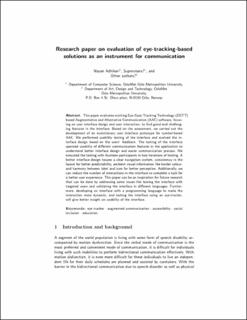Evaluation of eye-tracking-based solutions as an instrument for communication
Master thesis
Published version
Permanent lenke
https://hdl.handle.net/11250/2774803Utgivelsesdato
2021Metadata
Vis full innførselSamlinger
Sammendrag
Communication is an essential component of human social life. Conditions that produce speech impairment impose difficulties for communication that are often compensated by cumbersome yet functional strategies. When these conditions are associated with whole-body paralysis, these strategies are ineffective, leading to social isolation, which ultimately enhances the extreme difficulties to carry on standard daily routines. Assistive technologies come into the picture as a set of alternative strategies to enable users with special needs to communicate.
This thesis aims to explore and evaluate existing commercial and free electronic eye gaze-tracking (EGTT) based augmented and alternative communication (AAC) technologies available in the market. An electronic EGTT based AAC technologies are a group of technologies, both hardware and software, that work together to enhance or replace existing modes of communication. These technologies are helpful to the people who face trouble using traditional methods of communication and require assistants while performing communication. Technologies available in the market, both free and commercial solutions, are challenging to use and out of reach of people. Several factors make these solutions complex to use and inaccessible, including the communication process, basic literacy requirement, language skills, cost of technologies and dependency of these solutions on other expensive technologies.
Furthermore, we also discuss possible improvements to these existing solutions. The improved solution will address the speed of the communication process, require less literacy, available in multiple languages, and cross-platform support. Ultimately making the alternative and augmentative communication process for people living with speech and movement impairment easier, faster and more accessible.
